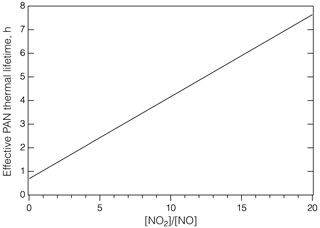Alvarado, M. J., Logan, J. A., Mao, J., Apel, E., Riemer, D., Blake, D., Cohen, R. C., Min, K.-E., Perring, A. E., Browne, E. C., Wooldridge, P. J., Diskin, G. S., Sachse, G. W., Fuelberg, H., Sessions, W. R., Harrigan, D. L., Huey, G., Liao, J., Case-Hanks, A., Jimenez, J. L., Cubison, M. J., Vay, S. A., Weinheimer, A. J., Knapp, D. J., Montzka, D. D., Flocke, F. M., Pollack, I. B., Wennberg, P. O., Kurten, A., Crounse, J., Clair, J. M. St., Wisthaler, A., Mikoviny, T., Yantosca, R. M., Carouge, C. C., and Le Sager, P.: Nitrogen oxides and PAN in plumes from boreal fires during ARCTAS-B and their impact on ozone: an integrated analysis of aircraft and satellite observations, Atmos. Chem. Phys., 10, 9739–9760, https://doi.org/10.5194/acp-10-9739-2010, 2010.
Chai, J.: Author comment 1, https://doi.org/10.5194/acp-2021-225-AC1, 2021.
Chai, J., Dibb, J. E., Anderson, B. E., Bekker, C., Blum, D. E., Heim, E., Jordan, C. E., Joyce, E. E., Kaspari, J. H., Munro, H., Walters, W. W., and Hastings, M. G.: Isotopic evidence for dominant secondary production of HONO in near-ground wildfire plumes, Atmos. Chem. Phys., 21, 13077–13098, https://doi.org/10.5194/acp-21-13077-2021, 2021.
Grosjean, D., Fung, K., Collins, J., Harrison, J., and Breitung, E.: Portable generator for on-site calibration of peroxyacetyl nitrate
analyzers, Anal. Chem., 56, 569–573, 1984.
Grosjean, D. and Harrison, J., Peroxyacetyl nitrate: Comparison of alkaline
hydrolysis and chemiluminescence methods, Environ. Sci. Technol., 19,
749–752, 1985.
Juncosa Calahorrano, J. F., Lindaas, J., O'Dell, K., Palm, B. B., Peng, Q.,
Flocke, F., Pollack, I. B., Garofalo, L. A., Farmer, D. K., Pierce, J. R.,
Collett Jr., J. L., Weinheimer, A., Campos, T., Hornbrook, R. S., Hall, S.
R., Ullman, K., Pothier, M. A., Apel, E. C., Permar, W., Hu, L., Hills, A.
J., Montzka, D., Tyndall, G. S., Thornton, J. A., and Fischer, E. V.:
Daytime oxidized reactive nitrogen partitioning in western U.S. wildfire
smoke plumes, J. Geophys. Res., 126, e2020JD033484, https://doi.org/10.1029/2020JD033484, 2020.
Kabir, M., Jagiella, S., and Zabel, F.: Thermal stability of n-acyl
peroxynitrates, Int. J. Chem Kinet., 46, 462–469, 2014.
Kirchner, F., Mayer-Figge, A., Zabel, F., and Becker, K. H.: Thermal
stability of peroxynitrates, Int. J. Chem. Kinet., 31, 127–144, 1999.
McClure, C. D. and Jaffe, D. A.: Investiation of high ozone events due to wildfire
samoke in an urban area, Atmos Environ., 194, 146–157, 2018.
Roberts, J.: Referee comment 1,
https://doi.org/10.5194/acp-2021-225-RC1.
Roberts, J. M.: The atmospheric chemistry of organic nitrates, Atmos.
Environ., 24A, 243–287, 1990.
Roberts, J. M., Flocke, F., Stroud, C. A., Hereid, D., Williams, E. J.,
Fehsenfeld, F. C., Brune, W., Martinez, M., and Harder, H.: Ground-based
measurements of PANs during the 1999 Southern Oxidants Study Nashville
intensive, J. Geophys. Res., 107, 4554, https://doi.org/10.1029/2001JD000947, 2002.
Roberts, J. M., Marchewka, M., Bertman, S. B., Sommariva, R., Kuster, W. C.,
Goldan, P. D., Williams, E. J., Lerner, B. M., and Fehsenfeld, F. C.:
Measurements of peroxycarboxylic nitric anhydrides off the coast of the
northeast United States during the New England Air Quality Study, (NEAQS)
2002, J. Geophys. Res., 112, D20306, https://doi.org/10.1029/2007JD008667, 2007.
Sander, R.: Compilation of Henry's law constants (version 4.0) for water as solvent, Atmos. Chem. Phys., 15, 4399–4981, https://doi.org/10.5194/acp-15-4399-2015, 2015.
Steer, R. P., Darnall, K. R., and Pitts Jr., J. N.: The base-induced
decomposition of peroxyacetylnitrate, Tetrahedron Lett., 43, 3765–3767, 1969.
Stephens, E. R.: The formation, reactions, and properties of peroxyacyl
nitrates (PANs) in photochemical air pollution, Adv. Environ. Sci., 1,
119–146, 1969.
Talukdar, R. K., Burkholder, J. B., Schmoltner, A.-M., Roberts, J. M.,
Wilson, R. R., and Ravishankara, A. R.: Investigation of the loss processes
for peroxyacetyl nitrate in the atmosphere: UV photolysis and reaction with
OH, J. Geophys. Res., 100, 14163–14173, 1995.






